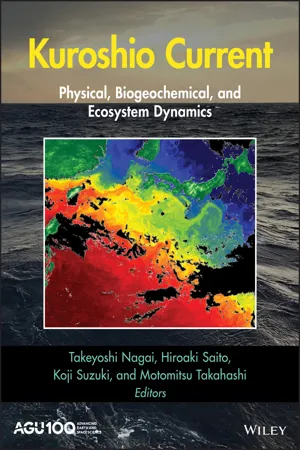
eBook - ePub
Kuroshio Current
Physical, Biogeochemical, and Ecosystem Dynamics
This is a test
- English
- ePUB (mobile friendly)
- Available on iOS & Android
eBook - ePub
Kuroshio Current
Physical, Biogeochemical, and Ecosystem Dynamics
Book details
Book preview
Table of contents
Citations
About This Book
An interdisciplinary study of the Kuroshio nutrient stream
The surface water of the Kuroshio, a western boundary current in the North Pacific Ocean, is nutrient-depleted and has relatively low primary productivity, yet abundant fish populations are supported in the region. This is called the "Kuroshio Paradox".
Kuroshio Current: Physical, Biogeochemical and Ecosystem Dynamics presents research from a multidisciplinary team that conducted observational and modeling studies to investigate this contradiction. This timely and important contribution to the ocean sciences literature provides a comprehensive analysis of the Kuroshio.
Volume highlights include:
- New insights into the role of the Kuroshio as a nutrient stream
- The first interdisciplinary examination of the Kuroshio Paradox
- Reflections on the influence of the Kuroshio on Japanese culture
- Research results on both the lower and higher trophic levels in the Kuroshio ecosystem
- Comparisons of nutrient dynamics in the Kuroshio and Gulf Stream
- Predictions of ecosystem responses to future climate variability
Frequently asked questions
At the moment all of our mobile-responsive ePub books are available to download via the app. Most of our PDFs are also available to download and we're working on making the final remaining ones downloadable now. Learn more here.
Both plans give you full access to the library and all of Perlego’s features. The only differences are the price and subscription period: With the annual plan you’ll save around 30% compared to 12 months on the monthly plan.
We are an online textbook subscription service, where you can get access to an entire online library for less than the price of a single book per month. With over 1 million books across 1000+ topics, we’ve got you covered! Learn more here.
Look out for the read-aloud symbol on your next book to see if you can listen to it. The read-aloud tool reads text aloud for you, highlighting the text as it is being read. You can pause it, speed it up and slow it down. Learn more here.
Yes, you can access Kuroshio Current by Takeyoshi Nagai, Hiroaki Saito, Koji Suzuki, Motomitsu Takahashi in PDF and/or ePUB format, as well as other popular books in Sciences physiques & Géologie et sciences de la Terre. We have over one million books available in our catalogue for you to explore.
Information
Section III
Ecosystem Dynamics
12
Phytoplankton Distribution in the Kuroshio Region of the Southern East China Sea in Early Spring
Toru Hasegawa, Satoshi Kitajima, and Yoko Kiyomoto
Seikai National Fisheries Research Institute, Japan Fisheries Research and Education Agency, Nagasaki, Japan
ABSTRACT
To examine the relationship between the distribution of phytoplankton and environmental conditions, two survey cruises were carried out during the spawning season of Trachurus japonicus in the Kuroshio region of the southern East China Sea. Using a flow cytometer and a microscope, the dominance of Synechococcus and diatoms was revealed. Size‐fractionated chlorophyll a (Chl a) revealed the predominance of picophytoplankton (<2 µm). Cell abundance of diatoms was higher when Chl a concentration was over 1 µg l−1.Around the Kuroshio axis, high temperature (>21 °C) water was distributed at a depth of approximately 200 m. From there, isotherms steeply shallowed to the north, implying the intrusion of nutrient‐rich Kuroshio subsurface waters onto the continental shelf. In stations around the shelf edges, mixed layer depths were lower than those in the surrounding stations, while nutrient concentrations of the surface layers were higher than those of the Kuroshio surface waters. This condition might contribute to the occurrence of patchy high Chl a concentrations, which could lead to high herbivore activity, followed by the improvement in food availability for larval and juvenile fish. Therefore, T. japonicus used the shelf edge region as the main spawning ground in early spring.
12.1. INTRODUCTION
Primary production in oceans is a key component of marine food webs, and phytoplankton are the dominant primary producers. Growth of phytoplankton is limited by factors such as light, nutrients, carbon dioxide, and temperature, and it shows variations with time and space. Thus, several efforts have been directed towards the estimation of primary production and growth of phytoplankton (Steemann‐Nielsen, 1952; Landry & Hassett, 1982; Longhurst et al., 1995).
The East China Sea (ECS), located on the western edge of the North Pacific, possesses one of the largest continental shelves in the world. The Kuroshio, a western boundary current in the North Pacific Ocean, flows northeastward along the shelf edge of the ECS, which is usually represented by the 200 m isobath. The ECS is known as an area of high primary productivity, and thus many studies have been conducted to elucidate the relationships between community structures of phytoplankton and their environments (Furuya et al., 2003; Jiao et al., 2005; Guo et al., 2014a, 2104b; Liu et al., 2016). Although the ECS consists of several complex water masses (Chen et al., 1995; Ichikawa & Beardsley, 2002), it is roughly divided into three water masses: the coastal water, which is influenced by the Changjiang outflow; the Kuroshio water around the shelf edge region with high temperature and salinity; and the mixed shelf water between them (Jiao et al., 2005; Guo et al., 2014a, 2104b). Guo et al. (2014a) reported higher abundance of phytoplankton in the coastal wat...
Table of contents
- COVER
- TABLE OF CONTENTS
- CONTRIBUTORS
- PREFACE
- Section I Introduction
- Section II Physical and Biogeochemical Dynamics
- Section III Ecosystem Dynamics
- INDEX
- END USER LICENSE AGREEMENT